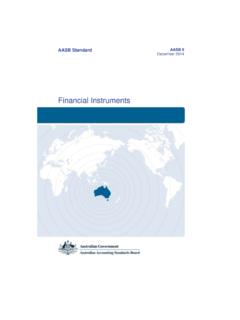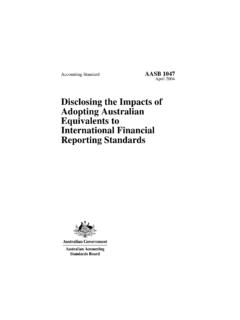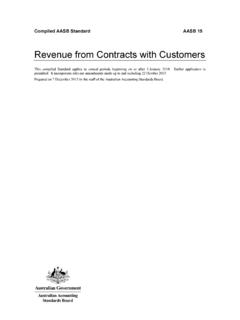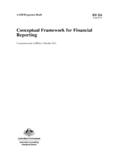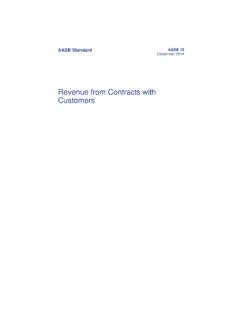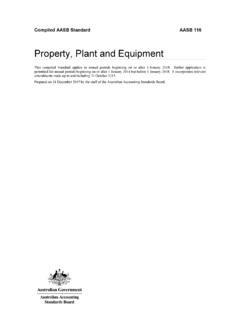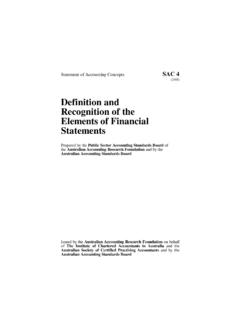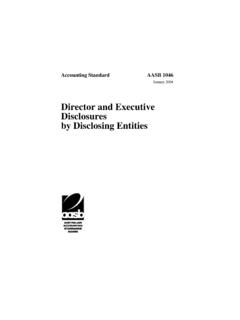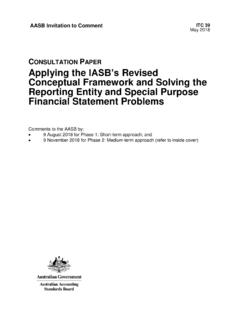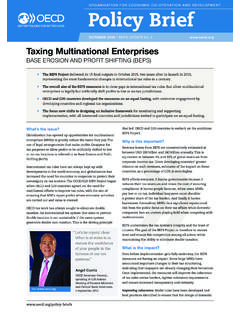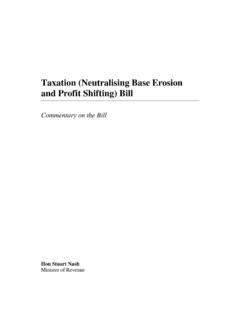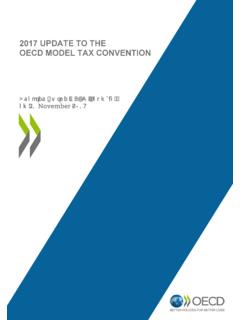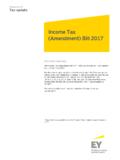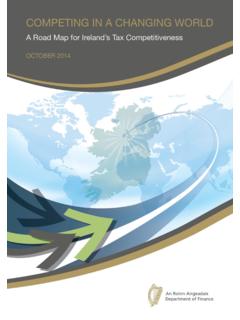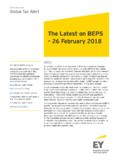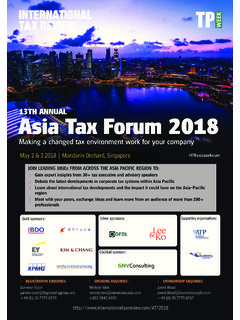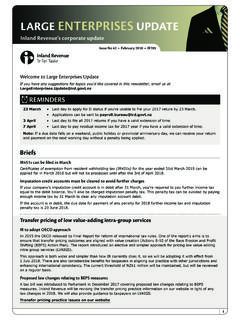Transcription of Tax disclosures ASAF - Australian Accounting …
1 Staff Paper Topic: Country-by-country reporting: update on AASB approach Meeting ASAF December 2016 Agenda Item: 10 Principal authors: Garima Ahuja (03) 9617 7620 Evelyn Ling (03) 9617 7631 Executive summary 1 In recent years, the global scrutiny in relation to the income tax practices adopted by multinational corporate groups has intensified with a particular focus on base erosion and profit shifting. In this regard, the OECD has made a number of recommendations not only in respect of strengthening tax laws across jurisdictions, but has also focused on the effectiveness of tax transparency in combating aggressive income tax structuring. In Australia, the Australian Government has enacted laws requiring greater tax transparency, and companies have started reporting in accordance with these new laws. The United Kingdom, United States and European Union (EU) have also been developing proposals and requirements for income tax disclosures to be made both within and outside of financial reports.
2 2 While much of the tax transparency initiative to date has been driven by the tax authorities, as part of remaining relevant in an ever-changing regulatory environment, we consider that it is timely for Accounting standard-setters to take a leadership role in improving income tax disclosures for users of financial Question to ASAF members Q1 Do ASAF members agree, given the global focus on improving the tax transparency of multinational enterprises, it is timely for Accounting standard-setters to take a leadership role in improving income tax disclosures for users of financial reports? 1 In Australia, the AASB has been requested to develop guidance to assist entities in this process, given the Accounting nature of certain public information seen as important for tax transparency. 2 Should IAS 12 Income Taxes be amended? 3 AASB staff conducted preliminary research with a view to understanding whether there is a case for amending IAS 12 to address user needs for greater transparency with respect to an entity s tax practices.
3 AASB staff: reviewed the income tax disclosures of a sample of Australian headquartered (a)multinational corporate groups that voluntarily sought to improve their tax transparency to users by making supplementary income tax disclosures to those required under IAS 12 both within and outside of financial reports; met with a number of preparers, analysts and representatives from tax (b)authorities; considered the work performed by the FASB with respect to revisions to tax (c) disclosures , and developments in other jurisdictions; reviewed relevant academic literature. (d)4 Our research suggests that improvements to income tax disclosures are required to provide greater tax transparency as to the linkage between: income tax amounts disclosed in the financial statements; (a) a corporate group s income tax liability; and (b) income taxes paid to tax authorities. (c)5 AASB staff note that preparers were not averse to making further disclosures to communicate additional income tax information they consider to be useful to users (not necessarily the tax authority).
4 However, care is necessary to maintain simplicity of presentation and avoid disclosure overload. 6 In summary, our research suggests that users would like to better understand why: income tax expense (or income tax payable) deviates from the corporate (a)income tax rate (being 30% in Australia); the relationship income tax expense bears to income taxes paid and payable; (b)and the overall relationship between the income tax amounts reported in the (c)financial statements. Recommended amendments to IAS 12 7 Consequently, AASB staff recommend that standard-setters should take the opportunity to consider amending IAS 12 to address the following disclosure objective: For an entity to disclose sufficient information to enable users of financial statements to understand: 3 (a) the relationship between income tax amounts reported in the financial statements; and (b) why reported tax expense deviates from the corporate income tax rate. 8 To meet this disclosure objective, AASB staff suggest consideration of one or more of the following (see paragraph 41 for further detail), in addition to the disclosures already specified by IAS 12: Reconciliation of Accounting profit before tax to income tax paid and payable; (a) Explanation of key items adjusting Accounting profit before tax to current tax (b)expense; Group and domestic income tax paid and payable ratio; (c) Reconciliation of group net current tax liability; (d) Significant amounts of income tax paid in foreign jurisdictions; and (e) Disclosure of Accounting profit before tax of domestic entities, domestic (f)income tax payable, and domestic and foreign income tax paid.
5 Question to ASAF members Q2 Do ASAF members consider the proposed income tax disclosures (outlined in Appendix 1) to provide users of general purpose financial statements with a better understanding of the income tax position of an entity? Do ASAF members have specific comments in respect of the four components? Do ASAF members have any other comments in this regard? Background 9 As part of the recent global focus on base erosion and profit shifting, governments around the world have considered the income tax practices of multinational enterprises, particularly with respect to the implementation of aggressive corporate income tax planning strategies. In response to the intensifying scrutiny, in 2013 the OECD developed a comprehensive Action Plan consisting of 15 action items2 to address weaknesses in the international tax system. The OECD s findings in this regard covered a number of practices adopted by multinationals through mismatches in tax laws between jurisdictions, transfer pricing practices and challenges posed by the digital economy, but also considered the need for increased tax transparency between tax authorities and the public more generally as a key measure in targeting such practices.
6 Accordingly, a number of the action items proposed by the OECD were designed to address perceived weaknesses in the tax transparency of multinational enterprises. In October 2015 the OECD released its final report and recommended measures aimed at improving tax transparency including country-by 2 4 country-reporting, which a number of jurisdictions, including Australia3, have since legislated. Voluntary Tax Transparency Code 10 In response to the perceived need for greater tax transparency of multinational corporate taxpayers, in 2015 the Board of Taxation, an advisory body focused on improving the design of Australia s income tax laws, designed a Voluntary Tax Transparency Code (TTC) for consultation, with the final report released in February 2016. 4 The TTC sets out the minimum tax disclosures that the Board of Taxation consider to be meaningful to improving the transparency for users (particularly general public) of the tax affairs of multinational enterprises.
7 The TTC does not mandate the income tax disclosures to be made in financial reports, but rather, leaves the location and form of disclosure to the discretion of multinational corporate taxpayers. 11 The disclosure requirements of the TTC include, for corporate taxpayers with Australian aggregated turnover between A$100 million and A$500 million: a reconciliation of Accounting profit before tax (APBT) to income tax expense (a)(ITE) and to income taxes paid or payable; identification of material temporary and non-temporary differences; and (b) effective tax rates for Australian and global operations. (c)12 The TTC sets out further disclosures for corporate taxpayers with Australian aggregated turnover of A$500 million. 13 The Board of Taxation has asked the AASB to prepare guidance materials to assist corporate entities in preparing the disclosures required by the TTC, as well as develop a common definition of an effective tax rate (ETR). In response to the intense global scrutiny of multinational corporate groups and their income tax affairs, in 2014 the Australian Government conducted an inquiry in relation to corporate tax avoidance to which a number of Australian multinational corporate taxpayers were required to respond.
8 Accordingly, AASB staff understand the reason for identifying these disclosures in the TTC is to provide greater clarity to users, in particular the general public, regarding the income tax affairs of multinational corporations. The Board of Taxation has requested the AASB s involvement in order to achieve the Australian Government s overarching objective of improving the tax transparency of multinational corporate groups in a clear and comparable way. 14 Other laws aimed at improving the tax transparency of entities meeting certain turnover thresholds, including the disclosure of certain tax attributes (total income, taxable income, income tax payable as disclosed in the income tax return) by the Australian tax authorities, have also recently been enacted5 in Australia. The 3 Subdivision 815-E of the Income Tax Assessment Act 1997 (ITAA 1997) 4 5 Section 3C of the Taxation Administration Act 1953 (TAA 1953) 5 information is publicly available and published annually on the Australian Government s data 15 Given the global focus on improving the tax transparency of multinational enterprises, it is timely for Accounting standard setters to consider whether, and if so how, we should play a role in addressing the improvement of income tax disclosures for users of financial reports more generally.
9 Other Australian measures 16 In 2015, in response to the OECD s final recommendations on tax transparency measures, Australia enacted legislation7 forming part of the Australian income tax law requiring entities considered significant global entities meeting certain criteria to prepare country-by-country reports for submission to the Australian tax authorities within 12 months of the relevant entity s end of financial year. These measures are applicable to entities for incoming years commencing on or after 1 January 2016. Broadly, the country-by-country reports address three levels of information required to be submitted including: A statement relating to the global operations and activities and the pricing (a)policies relevant to transfer pricing. A statement relating to local operations, activities and dealings. (b) A statement relating to the allocation between countries of income, activities (c)conducted and taxes paid. 17 These disclosures are not publicly available. 18 The Australian Government also recently enacted further measures8 which require Australian tax authorities to publicly disclose certain tax attributes as reported in the income tax return for certain entities satisfying turnover threshold tests.
10 The following attributes are disclosed for privately held entities with turnover of A$200 million or more, and public entities with turnover of A$10 million or more: Total income; (a) Taxable income; (b) Tax payable; (c) Minerals Resource Rent Tax Payable; and (d) Petroleum Resource Rent Tax Payable. (e) 6 7 Subdivision 815-E of the ITAA 1997 8 Section 3C of the TAA 1953 6 19 The first report was published by the Australian tax authorities in December 2015, with information of over 1,800 entities disclosed9. Research focus and purpose 20 AASB staff conducted research regarding income tax disclosures as currently reported in the financial reports of Australian headquartered multinational and domestic corporate and stapled groups across a range of industries. The purpose of conducting this research was to understand how companies currently present disclosures pertaining to income taxes required under IAS 12, as well as other domestic income tax Specifically, AASB staff were seeking to understand whether the disclosure practices as currently adopted are meeting the needs of users.
